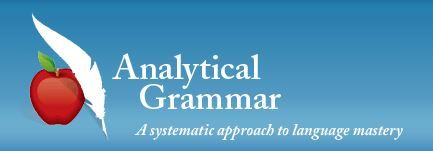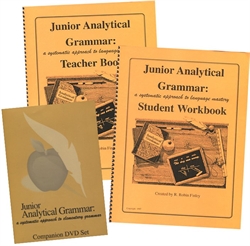
My husband and I were really excited to have the opportunity to have Haylee review this wonderful Junior Analytical Grammar and Companion DVDs by Analytical Grammar.
WHAT IS IT?:
Junior Analytical Grammar (Jr. AG) provides a very gentle introduction to grammar concepts for younger students in 4th or 5th grade. It is designed to be administered over a period of 11 weeks if working 5 days per week. This level is considered the first step in the Analytical Grammar series and would be followed by Junior Analytical Grammar: Mechanics before moving on to the regular Analytical Grammar program.
of 11 weeks if working 5 days per week. This level is considered the first step in the Analytical Grammar series and would be followed by Junior Analytical Grammar: Mechanics before moving on to the regular Analytical Grammar program.
Jr. AG covers all the parts of speech, five sentence patterns, the parts of a sentence, and classic sentence diagramming.
The Jr. AG set includes a spiral-bound teacher’s manual and one spiral-bound consumable student workbook for just $39.95.

In addition, there’s an optional Jr. AG Companion DVD set in which both authors alternate explaining the lessons and going over the first couple of sentences from each worksheet. They speak directly to the student, thereby teaching the lessons for you. This is a great convenience for just $19.95.
OUR EXPERIENCE:
My daughter, Haylee is almost 10 years old and just started 5th grade a few weeks ago. I should start by saying that she is not a fan of grammar work, and she made it clear she was not interested in doing a grammar-related review. However, her last CAT test showed me that while she’s doing fine, grammar-related work is truly her weakest subject area, and she definitely has room for improvement. So after much discussion, her father and I decided that it was in her best interest to give this program a try. And honestly, *I* was excited about it, even if she was not! I say all that to let you know that she is a reluctant participant in any grammar program, by no fault of the program itself!
We set out to work on this program 3 days per week on Mondays, Wednesdays, and Fridays, so it took us about a week and a half per unit. All of the units followed the same pattern of activities over a total of 5 actual workdays, and here’s a rundown of what each unit looked like:
- On day 1, Haylee watched the Companion DVD for the lesson instruction for about 10
minutes while following along in the student book. The speaker went over the first couple of practice sentences with her, pausing to give her a chance to work before explaining the answers. Then Haylee would complete the rest of the page on her own, asking me for help if she had any questions. Right off the bat, this helped build her confidence, and she surprisingly wanted to move on and work on the other worksheets, but I told her that spreading it out over a period of days was part of the process of making sure she remembered and had retained what she’d learned.
- On day 2, Haylee completed worksheet #2 in that unit and we would go over it using the answers in the teacher’s guide.
- On day 3, Haylee completed worksheet #3 in that unit, and we would go over it using the answers in the teacher’s guide.
- On day 4, Haylee did a worksheet called “Playing with Words.” This was a writing assignment to apply what she’d learned in the lesson and looked at it in a real world kind of way. This exercise might involve rewriting a paragraph or making up her own sentences using the given part of speech. This really helped demonstrate to me whether or not she understood practical application of what she’d learned. After co
mpleting the assignment, Haylee had to turn over on the back and complete the “How Did I Do” self-evaluation. I found that if she was allowed to do this on her own as it was intended, she would over-credit herself for doing it really well, even when she hadn’t satisfied the criteria for such a grade. So then I’d have to go back and evaluate it myself. I think the solution for this is that we should look at it together and talk about it as she completes the evaluation so there’s a more accurate assessment of her work.
- On day 5, Haylee completed the unit test, and I graded it. The teacher’s man
ual recommended that you only award points for each correctly identified word rather than deducting points for incorrect answers. I’d never taken that approach to grading before but found it rather refreshing and less stressful for me as the teacher, and it was certainly less stressful for Haylee as the recipient of the grade! A grading scale was also provided in the teacher’s manual that was broken down into either mastery, superiority, competency, probationary, or repeat. This, too, made it easy for me to truly evaluate just how I should view her performance.
With the first unit, Haylee did great with retention of the information we’d covered and did a good job of identifying the part of speech in the sentences. But as we progressed through additional units, it became a little more difficult for her to put it all together in her mind and keep doing it right. This is because each unit’s information is added to the knowledge from the previous lessons, making it incremental. Personally, I like this approach, but for Haylee, who struggles with these concepts, I think she may need to slow down a bit and have some extra practice before moving forward and combining it all together. Since there is no Review & Reinforcement book available until we get to the regular Analytical Grammar level, then the remedy may just be that I will have to make up some extra sentences for her to use for extra practice.
Overall, I really like this program. I really appreciate the grading approach and the way it allows me to buil
I do feel that Haylee is benefiting from the instruction and the approach of the program, but she may need me to help her along a bit with the practice worksheets, maybe by prom
Any dislike that Haylee expressed was not for the program, but for grammar in general. But in fact, I felt like she was more cooperative with this than other approaches we’ve tried. I really appreciated that the daily lessons were simple and to the point and not too time-consuming, because it stood a better chance of keeping her attention and not burning her out.
I really do recommend that you give this program a try! And if you can afford it, give yourself a break from teaching and treat yourself to the Companion DVD, as well. I found the whole presentation to be refreshing.
Take a look at what other Crew members had to say about this and other products from Analytical Grammar by clicking the banner below.




No comments:
Post a Comment